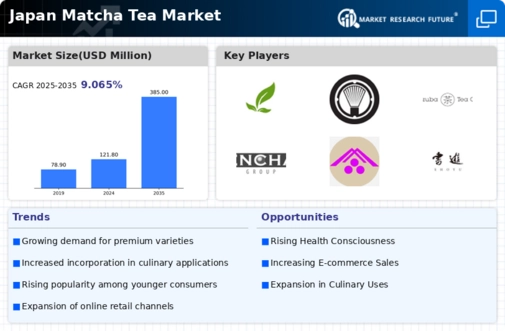The matcha tea market exhibits a dynamic competitive landscape, characterized by a blend of traditional practices and modern innovations. Key growth drivers include increasing health consciousness among consumers, the rising popularity of matcha in various culinary applications, and the expansion of e-commerce platforms. Major players such as Ippodo Tea Co (Japan), Aiya (Japan), and Encha (US) are strategically positioned to leverage these trends. Ippodo Tea Co (Japan) focuses on maintaining high-quality standards and traditional cultivation methods, while Aiya (Japan) emphasizes sustainability and organic certifications. Encha (US) has carved a niche by promoting premium matcha sourced directly from Japan, appealing to health-conscious consumers. Collectively, these strategies foster a competitive environment that prioritizes quality, authenticity, and consumer engagement.
In terms of business tactics, companies are increasingly localizing manufacturing and optimizing supply chains to enhance efficiency and reduce costs. The market structure appears moderately fragmented, with several players vying for market share. However, the influence of key players is substantial, as they set quality benchmarks and consumer expectations. This competitive structure encourages innovation and differentiation, compelling smaller brands to adopt unique selling propositions to capture niche markets.
In October 2025, Ippodo Tea Co (Japan) launched a new line of organic matcha products aimed at health-conscious consumers. This strategic move not only aligns with the growing demand for organic products but also reinforces the company's commitment to quality and sustainability. By expanding its product range, Ippodo Tea Co (Japan) positions itself to attract a broader customer base, potentially increasing its market share in the premium segment.
In September 2025, Aiya (Japan) announced a partnership with a leading health food retailer to enhance its distribution network in North America. This collaboration is significant as it allows Aiya (Japan) to tap into the growing health food market, thereby increasing its visibility and accessibility to consumers. The partnership may also facilitate the introduction of new product lines tailored to local preferences, further solidifying Aiya's presence in the region.
In August 2025, Encha (US) introduced a subscription service for its matcha products, aiming to enhance customer loyalty and streamline purchasing processes. This initiative reflects a broader trend towards digitalization in the market, as companies seek to engage consumers through innovative platforms. By offering a subscription model, Encha (US) not only ensures consistent revenue but also fosters a community of matcha enthusiasts who are likely to advocate for the brand.
As of November 2025, current competitive trends in the matcha tea market include a pronounced focus on digitalization, sustainability, and the integration of AI technologies in supply chain management. Strategic alliances are increasingly shaping the landscape, enabling companies to pool resources and expertise. Looking ahead, competitive differentiation is expected to evolve, with a shift from price-based competition to a focus on innovation, technology, and supply chain reliability. This transition may redefine consumer expectations, compelling brands to prioritize quality and sustainability in their offerings.



















Leave a Comment